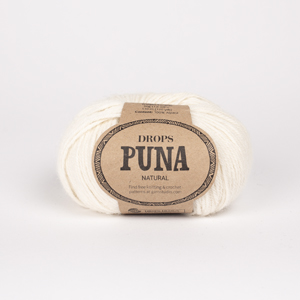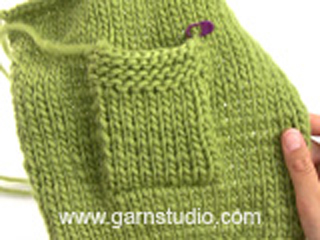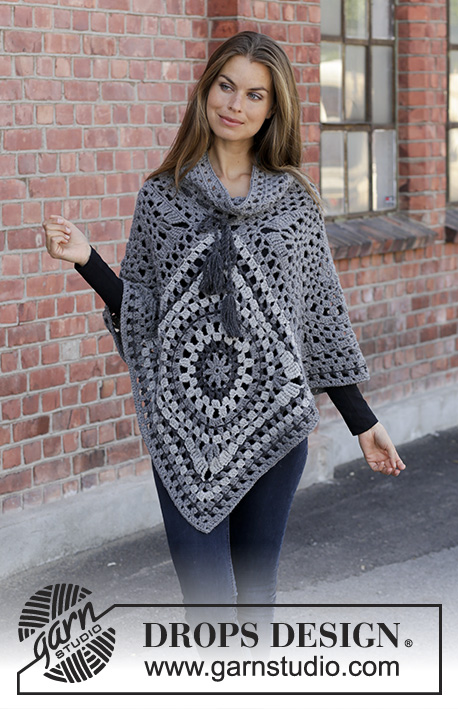Cosy Josie |
|||||||
 |
 |
||||||
Knitted jacket in DROPS Puna. The piece is worked in textured pattern with v-neck, short sleeves and pockets. Sizes S - XXXL.
DROPS 195-18 |
|||||||
|
INFORMATION FOR THE PATTERN: ------------------------------------------------------- RIDGE/GARTER STITCH (worked back and forth): 1 ridge = Knit 2 rows. PATTERN: See diagrams A.1 and A.2. The diagrams show all the rows in the pattern seen from the right side. BANDS: See diagram A.3 (right band when garment is worn) and A.4 (left band when garment is worn). The diagrams show all the rows in the pattern seen from the right side. . DECREASE TIP (for neckline): Decrease for neck inside the outermost 7 band stitches, i.e. the last band stitch is included in the decrease. All decreases are made from the right side! Decrease as follows after the 7 band stitches at the beginning of the row: Knit 2 stitches twisted together (= 1 stitch decreased). Decrease as follows before the 7 band stitches at the end of the row: Work as before until there are 9 stitches left on the row, knit 2 together and finish with 7 band stitches (= 1 stitch decreased). ------------------------------------------------------- START THE PIECE HERE: ------------------------------------------------------- JACKET - SHORT OVERVIEW OF THE PIECE: The piece is worked back and forth with circular needle in parts which are sewn together to finish. All the parts are worked bottom up. BACK PIECE: Cast on 129-137-145-155-165-177 stitches (including 1 edge stitch in each side) with circular needle size 5.5 mm and Puna. Purl 1 row (= wrong side). The next row is worked as follows from the right side: 1 edge stitch in GARTER STITCH – read description above, work A.1A until there are 2 stitches left on the row, work A.1B (= 1 stitch) and finish with 1 edge stitch in garter stitch. Continue the pattern like this. REMEMBER THE KNITTING TENSION! When the piece measures 36-38-38-40-40-42 cm cast off 2 stitches at the beginning of the next 2 rows for armholes = 125-133-141-151-161-173 stitches. Continue working until the piece measures 60-62-64-66-68-70 cm. READ THE WHOLE OF THE NEXT SECTION BEFORE CONTINUING! Now place stitches on a thread in each side for diagonal shoulders at the same time as decreasing for neck as follows: ROW 1 (right side): Work the first 6-7-7-8-9-9 stitches as before then place them on a thread, continue the pattern as before to end of row, turn the piece. ROW 2 (wrong side): Work the first 6-7-7-8-9-9 stitches as before, place them on 1 thread, continue the pattern as before to end of row, turn the piece. Repeat rows 1and 2 until you have placed stitches on a thread a total of 7 times in each side, then place 10-7-10-8-5-10 stitches on a thread 1 time in each side = 52-56-59-64-68-73 stitches on a thread on each side. AT THE SAME TIME when the piece measures 64-66-68-70-72-74 cm cast off the middle 17-17-19-19-21-23 stitches for neck and each shoulder is finished separately. Continue placing stitches on a thread for diagonal shoulder as before. In addition cast off 2 stitches on the next row from the neck. When all stitches are cast off and placed on a thread, the piece measures approx. 66-68-70-72-74-76 cm from the shoulder (by the neck) and down. RIGHT FRONT PIECE: Cast on 69-73-77-82-87-93 stitches (including 8 band stitches towards mid front and 1 edge stitch in the side) with circular needle size 5.5 mm and Puna. Purl 1 row (= wrong side). The next row is worked as follows from the right side: Work A.3 (= 8 stitches), work A.1A until there are 2 stitches left on the row, work A.1B (= 1 stitch) and finish with 1 edge stitch in garter stitch. Continue this pattern. When the piece measures 36-38-38-40-40-42 cm cast off 2 stitches for the armhole at the beginning of the next row from the wrong side = 67-71-75-80-85-91 stitches. AT THE SAME TIME when the piece measures 36-38-40-42-44-46 cm decrease 1 stitch for neck – read DECREASE TIP. Continue the pattern as before and decrease to neck as described above every 4-4-3½-3½-3-2½ cm a total of 7-7-8-8-9-10 times. AT THE SAME TIME when the piece measures 60-62-64-66-68-70 cm place stitches on a thread for the diagonal shoulders at the beginning of each row from the wrong side in the same way as for the back piece. In other words place 6-7-7-8-9-9 stitches on a thread a total of 7 times and then 10-7-10-8-5-10 stitches on a thread one time = 52-56-59-64-68-73 stitches on thread. When all the stitches are placed on a thread and the decreases to neck are finished, there are 8 stitches left on the needle and the piece measures approx. 66-68-70-72-74-76 cm from the shoulder (by the neck) and down. Continue the rib as before over the remaining 8 stitches for 8-8-8-8-9-9 cm (= neck edge). Cast off. LEFT FRONT PIECE: Cast on 69-73-77-82-87-93 stitches (including 1 edge stitch in the side and 8 band stitches towards mid front) with circular needle size 5.5 mm and Puna. Purl 1 row (= wrong side). The next row is worked as follows from the right side: 1 edge stitch in garter stitch, work A.1A until there are 9 stitches left on the row, work A.1B (= 1 stitch) and finish with A.4 over the 8 remaining stitches. Continue this pattern. When the piece measures 36-38-38-40-40-42 cm cast off 2 stitches at the beginning of the next row from the right side. AT THE SAME TIME when the piece measures 36-38-40-42-44-46 cm decrease 1 stitch for neck – read DECREASE TIP. Continue the pattern as before and decrease for neck as described above every 4-4-3½-3½-3-2½ cm a total of 7-7-8-8-9-10 times. AT THE SAME TIME when the piece measures 60-62-64-66-68-70 cm place stitches on a thread for diagonal shoulder at the beginning of each row from the right side in the same way as for the back piece. In other words place 6-7-7-8-9-9 stitches on a thread a total of 7 times and then 10-7-10-8-5-10 stitches on a thread one time = 52-56-59-64-68-73 stitches on a thread. When all stitches are placed on a thread and the decreases to neck are finished, there are 8 stitches left on the needle and the piece measures approx. 66-68-70-72-74-76 cm from the shoulder (by the neck) and down. Continue rib as before over the 8 remaining stitches for 8-8-8-8-9-9 cm (= neck edge). Cast off. SLEEVE: Cast on 98-98-106-106-114-114 stitches (including 1 edge stitch in each side) with circular needle size 5.5 mm and Puna. Purl 1 row (= wrong side). The next row is worked as follows from the right side: 1 edge stitch in garter stitch, work A.2A until there is 1 stitch left on the row and finish with 1 edge stitch in garter stitch. Continue this pattern until the piece measures approx. 24-24-26-26-28-28 cm. Loosely cast off with knit from the right side. Work the other sleeve in the same way. ASSEMBLY: Start with the 52-56-59-64-68-73 stitches from the thread on the one shoulder. Place these stitches on circular needle size 4.5 mm. Start from the right side and knit 1 row, but to avoid holes in each transition where stitches were placed on a thread, place the loop between the stitches in each transition on the needle and knit twisted together with the next stitch on the row. Knit 1 row from the wrong side, change to circular needle size 5.5 mm and then cast off with knit from the right side. Work the same edge on the 3 other shoulders. Sew the shoulder seams inside the cast-off edge. Sew the neck edge together mid back and sew the neck edge to the back of neck (make sure that the seam on the neck is in towards the wrong side of the garment). Fold the sleeves double lengthwise and sew the under-arm sleeves inside the 1 edge stitch in each side. Sew in sleeves. POCKET: Cast on 33-33-35-35-37-37 stitches (including 1 edge stitch in each side) with circular needle size 5.5 mm and Puna. Purl 1 row (= wrong side). The next row is worked as follows from the right side: 1 edge stitch in garter stitch, work A.2A until there are 2 stitches left on the row, work A.2B (= 1 stitch) and finish with 1 edge stitch in garter stitch. Continue this pattern until the pocket measures approx. 15-15-16-16-17-17 cm. Change to circular needle size 4.5 mm. Start from the right side and work 2 ridges back and forth over all stitches. Cast off with knit from the right side. The pocket measures approx. 16-16-17-17-18-18 cm from the top down. Work the other pocket in the same way. Place one pocket on each front piece approx. 8-9-10-11-12-13 cm from mid front and approx. 8-8-9-9-10-10 cm from the bottom edge (you can try the jacket on with the pockets to get the right position). Sew the pockets on with grafting stitches inside the 1 edge stitch. |
|||||||
Diagram explanations |
|||||||
|
|||||||

|
|||||||

|
|||||||
|
Have you made this or any other of our designs? Tag your pictures in social media with #dropsdesign so we can see them! Do you need help with this pattern?You'll find tutorial videos, a Comments/Questions area and more by visiting the pattern on garnstudio.com. © 1982-2024 DROPS Design A/S. We reserve all rights. This document, including all its sub-sections, has copyrights. Read more about what you can do with our patterns at the bottom of each pattern on our site. |
|||||||
























































Comments / Questions (10)
Will there be a crochet version of it? Or do you have an idea, how I can convert the pattern? Thanks in advance
09.03.2024 - 22:57DROPS Design answered:
Dear Bianca, we don't make custom patterns. The pattern is very rectangular so you could work rectangular crochet pieces of the same sizes as the body/sleeves and join them together but they will be much more heavier, tighter and less floaty than the garment's knitted version. Happy knitting!
10.03.2024 - 23:57Alors que l'on doit laisser 23 mailles au centre du dos pour l'encolure, a part les diminutions des encolures dans les bordures devant, on ne parvient pas à un intervalle équivalent sur les devants.....Ou passe - t-on le cou?
03.02.2022 - 23:11DROPS Design answered:
Bonjour Scrapayam, vous avez le même nombre de mailles à la fin du dos et de chaque devant pour les l'épaules, les 23 + 2 m de chaque côté pour l'encolure forment l'encolure dos, aucune maille du devant ne sera cousue contre ces mailles et formeront ainsi l'encolure dos; soit 27 mailles pour l'encolure = environ 14 cm (cf schéma). Bon tricot!
04.02.2022 - 09:05Is there a way to know what size the model is wearing?
22.10.2021 - 00:51DROPS Design answered:
Hi Portia, There is a measurements sketch at the bottom of the pattern, which gives the measurements for each size. Happy knitting!
22.10.2021 - 06:57Bonsoir, je souhaite faire le modèle COSY JOSIE, veste réalisée en qualité Puna, taille M. Par contre, la qualité de la laine retenue est KILD SILK couleur pétrole. avec les mêmes numéro soit : n° 5.5 et 4.5. Auriez-vous l'amabilité de me dire combien je dois commander de pelotes de laine dans la qualité KILD SILK par avance je vous en remercie
21.02.2020 - 19:05DROPS Design answered:
Bonjour Mme Fouilhoux, DROPS Kid-Silk appartient au groupe A de nos fils à tricoter, alors que cette veste se tricote en Puna, une laine du groupe B - notre convertisseur vous permettra de trouver les alternatives possibles - vous trouverez ici plus d'infos sur les alternatives. Bon tricot!
24.02.2020 - 07:57Bonjour N'y a t'il pas un oubli dans la légende des diagrammes: le petit rond noir signifie: maille endroit sur l'envers et ENVERS SUR L'ENDROIT? Merci!
22.09.2018 - 11:16DROPS Design answered:
Bonjour Mme Kaminski, tout à fait, la légende a été corrigée, merci. Bon tricot!
24.09.2018 - 14:37Woooow!!!
14.07.2018 - 16:56Simple, sweet, and snuggly - love this one bunches!!
07.06.2018 - 18:58Un bon basique pour les soirées d'hiver ! A décliner de toutes les couleurs ....
07.06.2018 - 11:15Cozy
06.06.2018 - 20:34Un gilet long un peu ample, très beau modèle !
05.06.2018 - 13:13